Status Demolished Units operational General Electric Construction began 1970 | Reactor supplier Westinghouse Decommission date 1992 | |
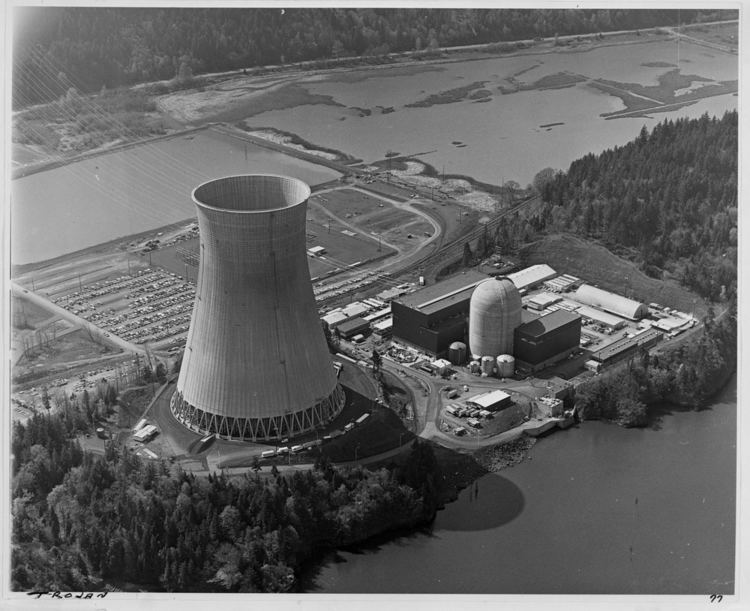 | ||
Construction cost Approximately$500 million Reactor type Pressurized water reactor (PWR) | ||
Trojan nuclear power plant cooling tower implosion
Trojan Nuclear Power Plant was a pressurized water reactor nuclear power plant in the northwest United States, located southeast of Rainier, Oregon, and the only commercial nuclear power plant to be built in Oregon. There was public opposition to the plant from the design stage. The three main opposition groups were the Trojan Decommissioning Alliance, Forelaws on the Board, and Mothers for Peace. There were largely non-violent protests from 1977, and subsequent arrests of participants.
Contents
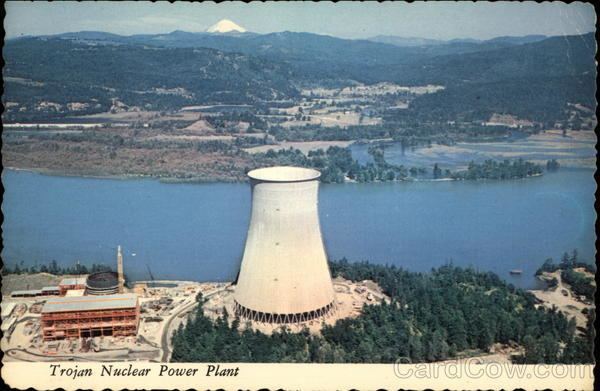
After sixteen years of service the plant was closed by its operator, Portland General Electric (PGE), after cracks were discovered in the steam-generator tubing. Decommissioning and demolition of the plant began in 1993 and was completed in 2006.
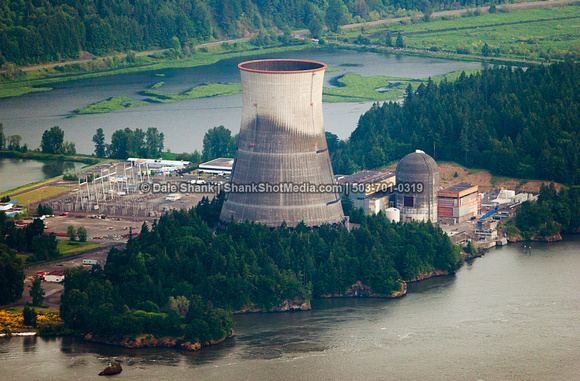
While operating, Trojan represented more than 12% of the electrical generation capacity of Oregon. The site lies about twelve miles north of St. Helens, Oregon, on the banks of the Columbia River.
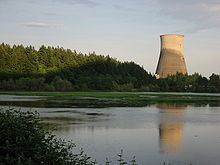
HistoryEdit

Construction of Trojan Nuclear Power Plant began February 1, 1970. First criticality was achieved on December 15, 1975, and grid connection on December 23, 1975. Commercial operation began on May 20, 1976, under a 35-year license to expire in 2011. The single 1130 megawatt unit at Trojan was then the largest pressurized water reactor built. It cost $460 million to build the plant.
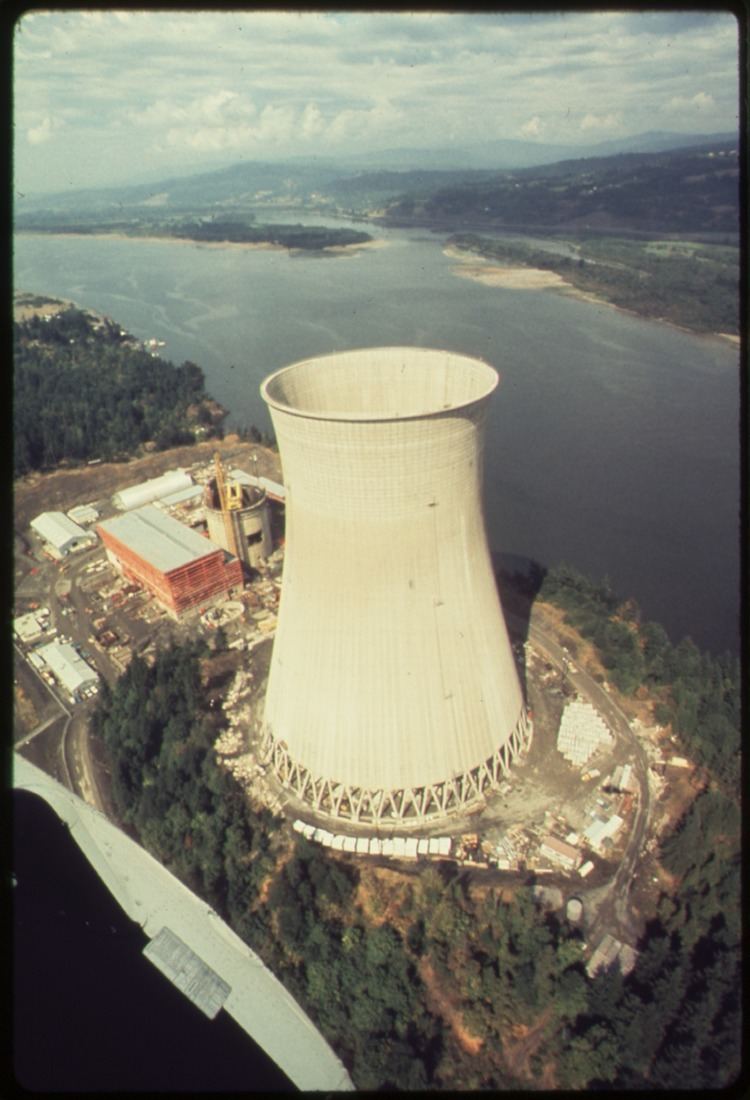
Environmental opposition dogged Trojan from its inception, and the opposition included non-violent protests organized by the Trojan Decommissioning Alliance. Direct action protests were held at the plant in 1977 and 1978, resulting in hundreds of arrests.
In 1978, the plant was closed for nine months while modifications were made to improve its resistance to earthquakes. This followed the discovery of both major building construction errors and the close proximity of a previously unknown fault. The operators sued the builders, and an undisclosed out-of-court settlement was eventually reached.
The Trojan steam generators were designed to last the life of the plant, but it was only four years before premature cracking of the steam tubes was observed.
In the 1980 Oregon election, a ballot measure to ban construction of further nuclear power plants in the state without federally approved waste facilities was approved by the voters 608,412 (53.2%) to 535,049 (46.8%). In 1986, a ballot measure initiated by Lloyd Marbet for immediate closure of the Trojan plant failed 35.7% yes to 64.3% no. This proposal was resubmitted in 1990, and again in 1992 when a similar proposal (by Jerry and Marilyn Wilson) to close the plant was also included. Each measure was soundly defeated by vote margins over 210,000 votes. Although all closure proposals were defeated, the plant operators committed to successively earlier closure dates for the plant.
In 1992, Portland General Electric (PGE) spent $4.5 million to defeat ballot measures seeking to close Trojan. It was, at the time, the most expensive ballot measure campaign in Oregon history. A week later the Trojan plant suffered another steam generator tube leak of radioactive water, and was shut down. It was announced that replacement of the steam generators would be necessary. In December 1992, documents were leaked from the U.S. Nuclear Regulatory Commission showing that staff scientists believed that Trojan might be unsafe to operate. In January 1993, chief plant engineer David Fancher, acting as spokesman for PGE, announced the company would not try to restart Trojan.
The spent fuel was transferred from cooling pools to 34 concrete and steel storage casks in 2003.
In 2005, the reactor vessel and other radioactive equipment were removed from the Trojan plant, encased in concrete foam, shrink-wrapped, and transported intact by barge along the Columbia River to Hanford Nuclear Reservation in Washington, where it was buried in a pit and covered with 45 ft of gravel, which made it the first commercial reactor to be moved and buried whole. The spent fuel is stored onsite in 34 dry casks. It was awaiting transport to the Yucca Mountain Repository until that project was canceled in 2009.
The iconic 499-foot-tall (152 m) cooling tower, visible from Interstate 5 in Washington and U.S. Route 30 in Oregon, was demolished via dynamite implosion at 7:00 a.m. on May 21, 2006. This event marked the first implosion of a cooling tower at a nuclear plant in the United States. Additional demolition work on the remaining structures continued through 2008. The central office building and the reactor building were demolished by Northwest Demolition and Dismantling in 2008. Remaining are five buildings: two warehouses, a small building on the river side, a guard shack, and offices outside the secured facility. It is expected that demolition of the plant will cost approximately $230,000,000. This cost includes the termination of the plant possession-only license, conventional demolition of the building and continuing cost for storage of used nuclear fuel.
A number of the air raid sirens that were originally installed within a ten-mile radius of Trojan, to warn of an incident at the plant that could endanger the general public, are still standing, in the towns of Longview, Washington, Kelso, Washington, and Kalama, Washington. Some of the other sirens, which have been removed, have been repurposed as tsunami warning sirens along the Oregon coast. While there are no plans to remove the remaining sirens, the city of Longview has removed a few of the sirens on an as-needed basis to make way for other projects.
HeliportEdit
Trojan Heliport (FAA LID: 3OR7) was a 60 x 60 ft. (18 x 18 m) private turf heliport located at the power plant. It appears to be defunct at this time.
